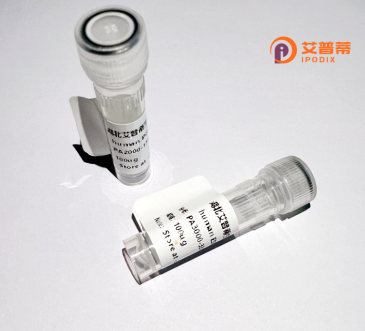
| 纯度 | >90%SDS-PAGE. |
| 种属 | Human |
| 靶点 | USP17 |
| Uniprot No | Q0WX57 |
| 内毒素 | < 0.01EU/μg |
| 表达宿主 | E.coli |
| 表达区间 | 1-530 aa |
| 活性数据 | MEDDSLYLRGEWQFNHFSKLTSSRPDAAFAEIQRTSLPEKSPLSCETRVDLCDDLAPVAR QLAPREKLPLSSRRPAAVGAGLQNMGNTCYVNASLQCLTYTPPLANYMLSREHSQTCHRH KGCMLCTMQAHITRALHNPGHVIQPSQALAAGFHRGKQEDAHEFLMFTVDAMKKACLPGH KQVDHHSKDTTLIHQIFGGYWRSQIKCLHCHGISDTFDPYLDIALDIQAAQSVQQALEQL VKPEELNGENAYHCGVCLQRAPASKTLTLHTSAKVLILVLKRFSDVTGNKIAKNVQYPEC LDMQPYMSQPNTGPLVYVLYAVLVHAGWSCHNGHYFSYVKAQEGQWYKMDDAEVTASSIT SVLSQQAYVLFYIQKSEWERHSESVSRGREPRALGAEDTDRRATQGELKRDHPCLQAPEL DEHLVERATQESTLDHWKFLQEQNKTKPEFNVRKVEGTLPPDVLVIHQSKYKCGMKNHHP EQQSSLLNLSSSTPTHQESMNTGTLASLRGRARRSKGKNKHSKRALLVCQ |
| 分子量 | 59.7 kDa |
| 蛋白标签 | His tag N-Terminus |
| 缓冲液 | PBS, pH7.4, containing 0.01% SKL, 1mM DTT, 5% Trehalose and Proclin300. |
| 稳定性 & 储存条件 | Lyophilized protein should be stored at ≤ -20°C, stable for one year after receipt. Reconstituted protein solution can be stored at 2-8°C for 2-7 days. Aliquots of reconstituted samples are stable at ≤ -20°C for 3 months. |
| 复溶 | Always centrifuge tubes before opening.Do not mix by vortex or pipetting. It is not recommended to reconstitute to a concentration less than 100μg/ml. Dissolve the lyophilized protein in distilled water. Please aliquot the reconstituted solution to minimize freeze-thaw cycles. |
1. **"USP17 regulates cell cycle progression and cancer development"**
- **作者**: Chen et al.
- **摘要**: 研究揭示了USP17通过去泛素化细胞周期蛋白(如Cyclin D1和Cyclin E1)调控细胞周期进程。敲低USP17导致细胞周期停滞,抑制肿瘤细胞增殖,提示其在癌症治疗中的潜在作用。
2. **"The deubiquitinase USP17 modulates inflammatory signaling by targeting TNF receptor-associated factors"**
- **作者**: Zhao et al.
- **摘要**: 报道USP17通过去泛素化TRAF2/6等炎症相关蛋白,调控NF-κB和MAPK信号通路,影响炎症因子(如IL-6、TNF-α)的产生,为炎症性疾病提供分子机制依据。
3. **"USP17-mediated deubiquitination of HDAC1/2 stabilizes oncogenic pathways in multiple cancers"**
- **作者**: Smith et al.
- **摘要**: 发现USP17通过稳定HDAC1/2的去泛素化状态,增强其表观遗传调控功能,促进肿瘤细胞侵袭和转移,提示USP17作为泛癌种治疗靶标的可能性。
4. **"Structural insights into the catalytic mechanism of USP17 and its substrate specificity"**
- **作者**: Lee et al.
- **摘要**: 通过解析USP17的晶体结构,揭示其催化结构域中关键氨基酸残基(如Cys和His)对底物识别和去泛素化活性的调控机制,为开发小分子抑制剂提供结构基础。
Ubiquitin-specific protease 17 (USP17), a member of the deubiquitinating enzyme family, plays a critical role in regulating protein stability and cellular signaling by removing ubiquitin chains from target substrates. First identified in 2003. human USP17 is encoded by a multi-copy gene cluster located on chromosome 8p23.1. a region associated with genomic instability and cancer susceptibility. Structurally, it contains conserved catalytic domains required for hydrolyzing ubiquitin linkages, along with variable N-terminal motifs that influence substrate specificity.
Functionally, USP17 modulates key pathways including cell cycle progression, apoptosis, and immune responses. It regulates Ras/MAPK and NF-κB signaling by deubiquitinating components like Ras and IκBα, thereby influencing cell proliferation and inflammation. Emerging studies highlight its dual roles in cancer, acting as both an oncogene (promoting lung and breast cancer growth) and tumor suppressor (inhibiting colorectal cancer metastasis), likely context-dependent based on tissue-specific substrates. USP17 also participates in cytoskeletal reorganization and chemokine receptor recycling, impacting cell migration and immune cell function.
Its expression is tightly controlled at transcriptional and post-translational levels, often dysregulated in pathological conditions. Despite therapeutic potential as a target for cancer and inflammatory diseases, challenges remain in understanding its broad substrate network and developing selective inhibitors. Current research focuses on unraveling USP17's pleiotropic roles through CRISPR screens and proteomic approaches to define context-dependent mechanisms.
×